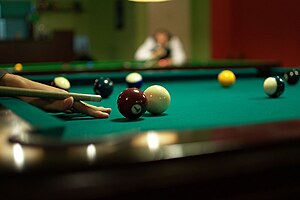Billiards
Billiards refers to games where players or teams hit balls with cues on a fabric-covered table. Modern billiards tables have rails around the edges to prevent balls from falling off and six pockets: one in each corner, and then one in the middle of each of the two longest rails. These tables are used for playing pocket billiards, commonly known as pool and snooker, though there are different sizes available for bars, homes, and tournaments[1]. The term 'billiards' originates from the game carom billiards, which is played using only three balls on a table without pockets. Pool, snooker, and carom billiards all use different types of balls.
In pocket billiards, commonly known as 'pool', two players or teams 15 numbered balls are set into a triangular shape using a rack. Each ball has a different color. Balls with numbers 1-8 are completely colored, while balls 9-15 have one stripe of color around them. The triangular rack is removed, and the solid white cue ball is positioned. Players must get the colored balls into pockets through only striking the cue ball with their cue; if they do, they get another turn. A variation of the game separates players into 2 teams, where one team targets the solidly-colored balls and the other targets the striped balls. The teams then target the 8-ball after they have struck all of their targeted balls into pockets.
History
Billiards games televised in America were often sponsored by cigarette brands, leading billiards to be heavily associated with smoking. This led to pharmaceutical companies to sponsor billiards games with nicotine substitutes, like nicotine gum and patches[2]
Billiards Terms in English Lexicon[3]
Due to billiards' longtime popularity, common terms from the game have found their way into the English lexicon. Though many of these terms were more prevalent in previous centuries, some of these phrases are still recognizable in modern English. The most common of which is "break," which in billiards refers to the positions balls end up in, and has become another word for good chance. This is most commonly seen in the phrases "lucky break" and "give me a break," which originate from billiards players hoping for better ball positioning. Another similar phrase occasionally still used is "those are the breaks" or "them's the breaks," which are meant to offer condolences to pool players whose shot put the balls in a bad position. Similar to "break" is "fluke," which also refers to something lucky. This term fell out of usage in billiards early, but remained part of the English lexicon.
The phrase "rack up" refers to scoring many points. This can originate from racking billiards balls on the table after a game or from the racks built into the sides of a billiards table that balls fall into after they are hit into a pocket. Commonly used today still is the phrase "call the shots," which means to state directions or intent. This phrase originates from games of pool in which players give directions to their opponents on what balls they should hit into which pocket.
Determining Billiards Paths Mathematically
Mathematicians have determined ways to characterize the path a billiards ball will take when hit, referred to as a billiard path.
References
- ↑ What is the Difference Between Billiards, Pool, and Snooker? by Christian Gould, posted on Legacy Billiards' blog on Oct. 22, 2019
- ↑ Move Over, Marlboro by David Simpson, originally published in Tobacco Control in summer 1998. Accessed through JSTOR.
- ↑ Billiards, Pool, and Snooker Terms in Everyday Use by Robert R. Craven, originally published in American Speech volume 55 in the summer of 1980. Accessed through JSTOR.
